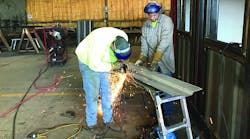RedGuard
Wichita, KS
Manufacturer of blast-resistant steel buildings
187 employees | 11 sites | 1 EHS professional
Read profiles on all the other 2019 America's Safest Companies!
At RedGuard, behavior is an important aspect of its safety culture. The company’s products—blast-resistant steel buildings—are designed to protect and keep people safe, and as Steve Crider, RedGuard’s safety compliance officer, explains, “It follows that our safety culture must exceed all RedGuard and client expectations to ensure that our employees work in a safe, healthful and compliant work environment.”
In 2015 the company committed to a large financial investment of $300,000 in a behavior-based safety (BBS) process to train all of its employees. The program has paid off as the company has reduced its OSHA-recordable injuries by 80% through 2018.
As part of the program at every company meeting or training an employee discusses a personal near-miss or incident that occurred at work, at home or even on the road. In addition, management engages with employees on safety-related issues at least once a week.
Also each week, two different production employees conduct a safety inspection of the facility as though an OSHA inspector was performing the task. They take photos of conditions and acts of concern, stop the unsafe conditions and acts, and provide guidance. “From this inspection we will sometimes stage an unsafe condition and if the employees identify it they will win a gift card that we present the following morning in front of all other employees to encourage the attitude of going above and beyond for safety,” says Crider.
Crider says the program has helped significantly in creating an awareness that individual, team and family safety matters and has become a core value to all employees. “Safety is never something to be compromised, taken for granted, and is never just good enough,” he emphasizes. “When our owner challenges each new employee to be the CEO of their own world, it is a huge wake up call to them that they are valued for their minds to help themselves and RedGuard grow in safety, quality and production.”
